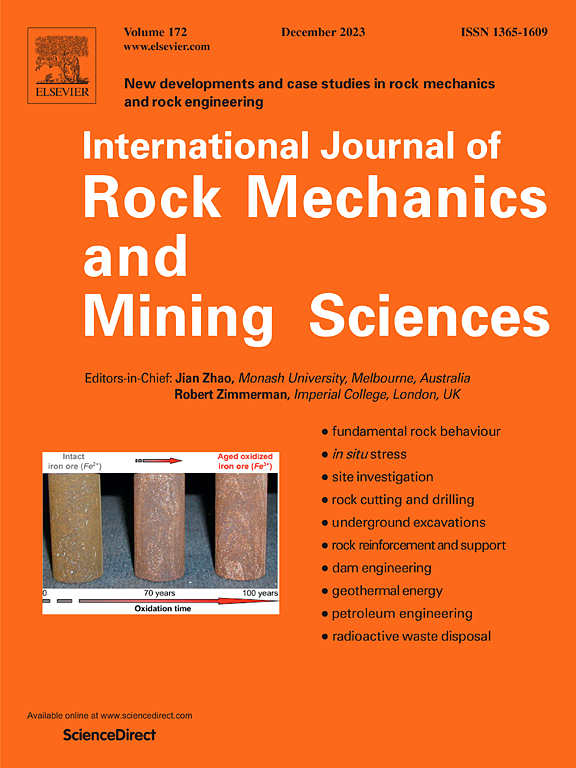A line-to-volume contact algorithm for modeling the complex bond-slip behavior of grouted bolts in rock mass
IF 7.5
1区 工程技术
Q1 ENGINEERING, GEOLOGICAL
International Journal of Rock Mechanics and Mining Sciences
Pub Date : 2025-07-19
DOI:10.1016/j.ijrmms.2025.106215
引用次数: 0
Abstract
Timely installation of rock bolts is essential in tunneling through weak surrounding rock to prevent rapid deformation behind the excavation face. However, understanding the support mechanism of rock bolts remains a challenge, primarily due to the highly nonlinear bond-slip behavior at the bolt-rock interface. This difficulty is further compounded by the large disparity in cross-sectional dimensions between the bolt and the surrounding rock mass. This study presents a novel and efficient finite element contact algorithm to simulate the interaction between rock bolts and the surrounding rock. Unlike conventional methods that establish direct contact constraints, our approach introduces relative displacement as the new degree of freedom (DOF) based on the dual Lagrange multiplier method. This new DOF is subsequently employed in the discretization of contact constraints and contact virtual work. The formulation enables direct integration of existing constitutive models for the bolt-rock interface, which are typically expressed in terms of relative slip displacement. In addition, it improves numerical stability by avoiding the saddle-point problems and spurious stress oscillations commonly observed in traditional contact formulations. Moreover, this method accommodates non-conforming meshes, enabling the rock bolt to be meshed separately and arbitrarily assembled into the mesh of the rock mass, thus enhancing the flexibility of numerical modeling. The accuracy and efficiency of our method are first validated against existing methods. Subsequently, the developed algorithm is applied to perform a detailed analysis of the mechanical response and support mechanism of rock bolts during tunnel excavation.
一种模拟岩体中注浆锚杆复杂粘结滑移行为的线-体接触算法
在软弱围岩隧道施工中,及时安装锚杆是防止开挖面后快速变形的关键。然而,了解锚杆的支护机制仍然是一个挑战,主要是由于锚杆-岩石界面高度非线性的粘结滑移行为。锚杆与围岩截面尺寸的巨大差异进一步加剧了这一困难。本文提出了一种新颖、高效的有限元接触算法来模拟锚杆与围岩之间的相互作用。与建立直接接触约束的传统方法不同,该方法基于对偶拉格朗日乘子方法引入了相对位移作为新的自由度。随后将该自由度应用于接触约束和接触虚功的离散化。该公式可以直接集成现有的螺栓-岩石界面本构模型,这些本构模型通常以相对滑移位移表示。此外,它还避免了传统接触公式中常见的鞍点问题和虚假应力振荡,从而提高了数值稳定性。此外,该方法还可以容纳非一致性网格,使锚杆可以单独划分网格,也可以任意组合到岩体的网格中,从而提高了数值模拟的灵活性。首先通过与现有方法的对比,验证了该方法的准确性和效率。随后,应用该算法对隧道开挖过程中锚杆的力学响应及支护机理进行了详细分析。
本文章由计算机程序翻译,如有差异,请以英文原文为准。
求助全文
约1分钟内获得全文
求助全文
来源期刊
CiteScore
14.00
自引率
5.60%
发文量
196
审稿时长
18 weeks
期刊介绍:
The International Journal of Rock Mechanics and Mining Sciences focuses on original research, new developments, site measurements, and case studies within the fields of rock mechanics and rock engineering. Serving as an international platform, it showcases high-quality papers addressing rock mechanics and the application of its principles and techniques in mining and civil engineering projects situated on or within rock masses. These projects encompass a wide range, including slopes, open-pit mines, quarries, shafts, tunnels, caverns, underground mines, metro systems, dams, hydro-electric stations, geothermal energy, petroleum engineering, and radioactive waste disposal. The journal welcomes submissions on various topics, with particular interest in theoretical advancements, analytical and numerical methods, rock testing, site investigation, and case studies.

 求助内容:
求助内容: 应助结果提醒方式:
应助结果提醒方式:


